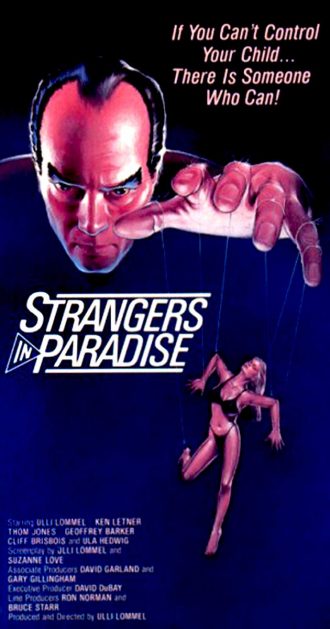 This ridiculous sci fi musical from the late R.W. Fassbinder acolyte Ulli Lommel wants very much to be a cult sensation a la REPO MAN or THE ROCKY HORROR PICTURE SHOW, but fails spectacularly. Like the vast majority of Lommel’s films (which include the 1973 classic THE TENDERNESS OF WOLVES and a myriad of none-too-classic follow ups) it’s noticeably cheap and indifferently made. Yet STRANGERS IN PARADISE (1984) is also very likely the most interesting entry in Lommel’s post-BOOGEY MAN (1980) oeuvre, being very much of a piece with better known eighties musical misfires like THE APPLE (1980) and SHOCK TREATMENT (1981).
This ridiculous sci fi musical from the late R.W. Fassbinder acolyte Ulli Lommel wants very much to be a cult sensation a la REPO MAN or THE ROCKY HORROR PICTURE SHOW, but fails spectacularly. Like the vast majority of Lommel’s films (which include the 1973 classic THE TENDERNESS OF WOLVES and a myriad of none-too-classic follow ups) it’s noticeably cheap and indifferently made. Yet STRANGERS IN PARADISE (1984) is also very likely the most interesting entry in Lommel’s post-BOOGEY MAN (1980) oeuvre, being very much of a piece with better known eighties musical misfires like THE APPLE (1980) and SHOCK TREATMENT (1981).
Scripted by Lommel and his then wife Suzanna Love, it begins in Nazi Germany, visualized in black and white. There the supernaturally endowed mesmerist Jonathan Sage (Lommel) runs afoul of a very poorly played (again by Lommel) Adolph Hitler, and escapes to London. It’s there, in 1940, that Sage gets cryogenically frozen.
Cut to early 1980s Southern California—with the black and white film stock turning to muddy and under-saturated color—where in the sleepy suburban community of Paradise Hills a bunch of rebellious teens spend their days performing elaborate song and dance numbers. Back in London, meanwhile, Sage is being thawed out by singing medical technicians (“We gotta get him up so he can start gettin’ down!”), a development that’s eagerly followed by the stuffy conservative parents of the California teens, who want to utilize Sage’s powers to keep their children in line (Sage, FYI, at some point decamps from London to So Cal, the hows and whys of which are left unclear).
But Sage harbors rebellious sentiments, and after seeing the kids perform a music number in a bomb shelter comes to connect the actions of their parents with those of the Nazis he escaped. The adults want to consolidate his power over their children in a TV special that will showcase Sage’s powers, but he, of course, has other ideas.
Such is the story. Regarding the filmmaking, it’s undistinguished, with a confused narrative whose momentum is compromised by the near-constant musical numbers. Lommel panders rather shamelessly to an imagined 1980s youth demographic (with then-hip elements like break dancing and aerobicizing thrown in), and nor is he above flattering himself in the lead role, in which he’s told by a fellow performer that he “doesn’t look a day over thirty” (when in actuality Lommel was pushing forty).
Also on hand is actor/musician Richard Green (who speaks of STRANGERS IN PARADISE at some length, and includes an extended clip from it, in his 2003 docu-musical 7 YEAR ZIG-ZAG), the writer and performer of the film’s most memorable song, a jazzy neo-swing number that feels out of place amid the eighties-centric tunes that clot the rest of the film. Those tunes include subversive-for-the-era lyrics like “I wanna make it with my own kind…and I like it just fine!,” as well as “What a lovely day to control the world, I dig it! I dig it! I dig it! I dig it!,” and “They’re all crazy, everyone knows, they’ll even try to change the burning sand into snow!“
So STRANGERS IN PARADISE isn’t a completely non-worthwhile film. That’s particularly true now, nearly forty years after its inception, when the film’s period specific silliness has taken on a nostalgic sheen, resulting in a viewing experience that is, simply, fun.
Vital Statistics
STRANGERS IN PARADISE
New West Films
Director/Producer: Ulli Lommel
Screenplay: Ulli Lommel, Suzanna Love
Cinematography: Juerg V. Walther
Editing: Ron Norman
Cast: Ulli Lommel, Ken Letner, Thom Jones, Geoffrey Barker, Cliff Brisbois, Paul Murray, Gloria McCord, Ann Price, Bette Chapel, Evakay Favia, Richard Green, Galyn Gorg, Ula Hedwig, Rick Chaff, Billy Pettyjohn, Steve Adore, Moonlight Drive
